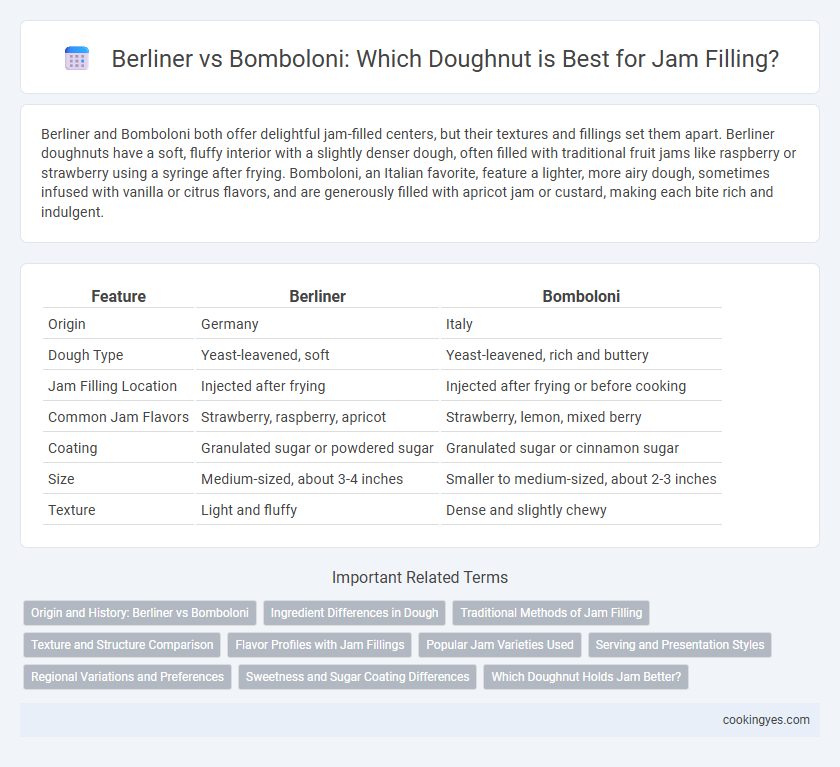Berliner and Bomboloni both offer delightful jam-filled centers, but their textures and fillings set them apart. Berliner doughnuts have a soft, fluffy interior with a slightly denser dough, often filled with traditional fruit jams like raspberry or strawberry using a syringe after frying. Bomboloni, an Italian favorite, feature a lighter, more airy dough, sometimes infused with vanilla or citrus flavors, and are generously filled with apricot jam or custard, making each bite rich and indulgent.
Table of Comparison
| Feature | Berliner | Bomboloni |
|---|---|---|
| Origin | Germany | Italy |
| Dough Type | Yeast-leavened, soft | Yeast-leavened, rich and buttery |
| Jam Filling Location | Injected after frying | Injected after frying or before cooking |
| Common Jam Flavors | Strawberry, raspberry, apricot | Strawberry, lemon, mixed berry |
| Coating | Granulated sugar or powdered sugar | Granulated sugar or cinnamon sugar |
| Size | Medium-sized, about 3-4 inches | Smaller to medium-sized, about 2-3 inches |
| Texture | Light and fluffy | Dense and slightly chewy |
Origin and History: Berliner vs Bomboloni
The Berliner originated in Germany during the 16th century as a yeast doughnut typically filled with plum or raspberry jam, reflecting its traditional European roots. In contrast, the Bomboloni traces back to Italy's Tuscany region, gaining popularity in the 18th century with its softer texture and custard or fruit jam fillings. Both doughnuts showcase regional variations influenced by local ingredients and culinary customs, highlighting distinct historical evolutions in Jam-filled pastries across Europe.
Ingredient Differences in Dough
The Berliner dough typically incorporates milk, eggs, and butter, creating a rich, tender texture ideal for jam filling, while Bomboloni dough often uses less fat and includes yeast with a higher hydration level, resulting in a lighter, fluffier pastry. Berliners emphasize a denser crumb that holds thicker jams well, whereas Bomboloni's airier structure allows for a more delicate jam distribution. These ingredient differences influence the overall mouthfeel and how each dough absorbs and complements the sweetness of the jam filling.
Traditional Methods of Jam Filling
Traditional jam filling methods for Berliner rely on injecting thick, fruit-based preserves such as raspberry or plum directly into the center after frying, ensuring a rich, concentrated flavor typical of German pastries. Bomboloni, originating from Italy, use a similar approach but often employ lighter, more gelatinous fillings made from citrus or apricot jams to complement their airy texture. Both pastries emphasize careful timing in the injection process to maintain moisture balance and preserve the delicate dough's integrity.
Texture and Structure Comparison
Berliners feature a light, airy crumb with a soft exterior that absorbs jam filling evenly, creating a balanced texture between dough and sweet interior. Bomboloni have a denser, chewier structure that holds a thicker jam filling without becoming soggy, offering a more substantial bite. The contrasting textures highlight Berliner's fluffy lightness versus Bomboloni's rich, satisfying chewiness in jam-filled doughnuts.
Flavor Profiles with Jam Fillings
Berliner doughnuts typically feature a dense, yeast-raised dough with a pronounced buttery flavor that balances the tartness of traditional raspberry or strawberry jam fillings, creating a classic European taste experience. Bomboloni, an Italian variant, offer a lighter, fluffier texture with a slightly sweet, vanilla-infused dough that enhances the sweetness and floral notes of apricot or mixed berry jams. Both doughnuts highlight their jam fillings differently: Berliner emphasizes a richer, deeper flavor contrast, while Bomboloni brings out a delicate, harmonious sweetness.
Popular Jam Varieties Used
Popular jam varieties used in Berliners typically include raspberry, strawberry, and blackcurrant, offering a sweet yet tangy flavor profile that complements the fluffy dough. Bomboloni often feature a wider range of fillings, with apricot, mixed berry, and lemon jam being common choices, providing a more diverse and vibrant taste experience. Both doughnuts emphasize fresh, fruit-based jams, but Berliners lean toward classic berry flavors while Bomboloni showcase regional and seasonal varieties.
Serving and Presentation Styles
Berliner doughnuts are traditionally served without a hole, featuring a soft, fluffy exterior dusted with powdered sugar and filled internally with jam, often presented on small paper doilies to emphasize their classic European appeal. Bomboloni, originating from Italy, typically showcase a round, puffy shape with the jam filling injected slightly off-center, often glazed with sugar and served warm, enhancing their rich, indulgent texture. Both varieties emphasize the visual contrast of filling and dough, but Berliners focus on a minimalist, elegant presentation while Bomboloni highlight a rustic, inviting look perfect for casual, cafe-style serving.
Regional Variations and Preferences
Berliners, traditionally popular in Germany and Austria, feature a dense, yeast-based dough filled with a thick strawberry or raspberry jam, reflecting Central European preferences for tart and slightly tangy flavors. Bomboloni, commonly found in Italy, especially Tuscany, use a lighter, fluffier dough with a sweeter variety of apricot or mixed fruit jam, catering to the Mediterranean palate. Regional variations highlight the contrasting textures and jam fillings, where Berliners emphasize a richer dough and sharper jam, while Bomboloni prioritize airy pastry and sweeter, more diverse fruit fillings.
Sweetness and Sugar Coating Differences
Berliner doughnuts typically feature a denser, yeast-based dough with a sweet, granulated sugar coating that balances the tartness of jam fillings like raspberry or apricot. Bomboloni, originating from Italy, are lighter and fluffier with a smoother, powdered sugar dusting that enhances the natural sweetness of fillings such as strawberry or vanilla cream jam. The difference in sugar coatings influences the overall sweetness perception, with Berliner offering a more textured bite and Bomboloni providing a delicate, melt-in-mouth experience.
Which Doughnut Holds Jam Better?
Berliner doughnuts excel at holding jam due to their traditionally thicker, denser dough and lack of a hole, which prevents filling leakage and keeps jam securely inside. Bomboloni, while also filled with jam, often have a lighter, airier texture that may allow the filling to escape more easily during cooking or eating. For optimal jam retention, Berliners provide a more reliable, mess-free experience.
Berliner vs Bomboloni for Jam Filling Infographic

 cookingyes.com
cookingyes.com